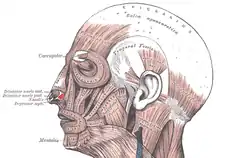| Dilator naris muscle | |
|---|---|
 Muscles of the head, face, and neck. | |
| Details | |
| Origin | margin of the nasal notch of the maxilla, greater and lesser alar cartilages |
| Insertion | skin near the margin of the nostril |
| Nerve | buccal branch of the facial nerve |
| Actions | dilates nostrils |
| Identifiers | |
| Latin | Pars alaris musculi nasalis |
| Anatomical terms of muscle | |
The dilator naris muscle (or alae nasi muscle) is a part of the nasalis muscle. It has an anterior and a posterior part. It has origins from the nasal notch of the maxilla and the major alar cartilage, and a single insertion near the margin of the nostril. It controls nostril width, including changes during breathing. Its function can be tested as an analogue for the function of the facial nerve (VII), which supplies it.
Structure
The dilator naris muscle is divided into posterior and anterior parts.
- The dilator naris posterior is placed partly beneath the levator labii superioris muscle. It arises from the margin of the nasal notch of the maxilla, and from the minor alar cartilages. It is inserted into the skin near the margin of the nostril.
- The dilator naris anterior is a delicate fasciculus. It originates from the lateral crus of the major alar cartilage, more laterally.[1][2] It inserts into the margin of the nostril, the alar groove.[1][2] It is situated in front of the dilatator naris posterior muscle.[1]
Nerve supply
The dilator naris muscle is supplied by the facial nerve (VII).[3]
Function
The dilator naris muscle has a role in widening and narrowing the nostril, along with other muscles.[3][4] It may prevent the collapse of the nostril during inhalation, particularly in people with narrower nostrils.[4] The respiratory centre of the brainstem can use the muscle to control nostril width in relation to breathing.[3][5] It also moves the tip of the nose slightly.[2]
Clinical significance
The function of the dilator naris muscle can be used as an analogue for the activity of the facial nerve (VII).[5]
History
The dilator naris muscle may also be known as the alae nasi muscle.[4]
References
![]() This article incorporates text in the public domain from page 382 of the 20th edition of Gray's Anatomy (1918)
This article incorporates text in the public domain from page 382 of the 20th edition of Gray's Anatomy (1918)
- 1 2 3 Hur, Mi-Sun; Hu, Kyung-Seok; Youn, Kwan-Hyun; Song, Wu-Chul; Abe, Shinichi; Kim, Hee-Jin (March 2011). "New anatomical profile of the nasal musculature: Dilator naris vestibularis, dilator naris anterior, and alar part of the nasalis". Clinical Anatomy. 24 (2): 162–167. doi:10.1002/ca.21115. PMID 21254248. S2CID 20852683.
- 1 2 3 Figallo, Eleazar E.; Acosta, Jaime A. (October 2001). "Nose Muscular Dynamics: The Tip Trigonum". Plastic and Reconstructive Surgery. 108 (5): 1118–1126. doi:10.1097/00006534-200110000-00003. PMID 11604607. S2CID 27776140.
- 1 2 3 Mann, Douglas G.; Sasaki, Clarence T.; Fukuda, Hiroyuki; Suzuki, Masafumi; Hernandez, Juan R. (May 1977). "Dilator Naris Muscle". Annals of Otology, Rhinology & Laryngology. 86 (3): 362–370. doi:10.1177/000348947708600314. PMID 869439. S2CID 30054259.
- 1 2 3 Bruintjes, T. D.; van Olphen, A. F.; Hillen, B.; Weijs, W. A. (November 1996). "Electromyography of the human nasal muscles". European Archives of Oto-Rhino-Laryngology. 253 (8): 464–469. doi:10.1007/BF00179951. PMID 8950546. S2CID 10923845.
- 1 2 Sasaki, C. T.; Mann, D. G. (1 June 1976). "Dilator Naris Function: A Useful Test of Facial Nerve Integrity". Archives of Otolaryngology–Head & Neck Surgery. 102 (6): 365–367. doi:10.1001/archotol.1976.00780110077009. PMID 1275805.